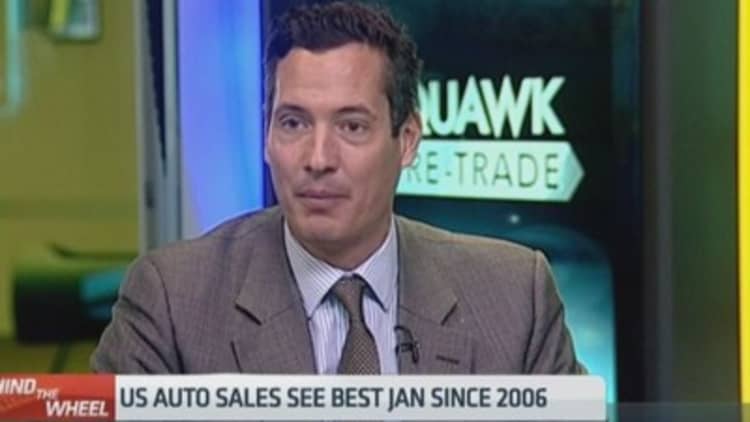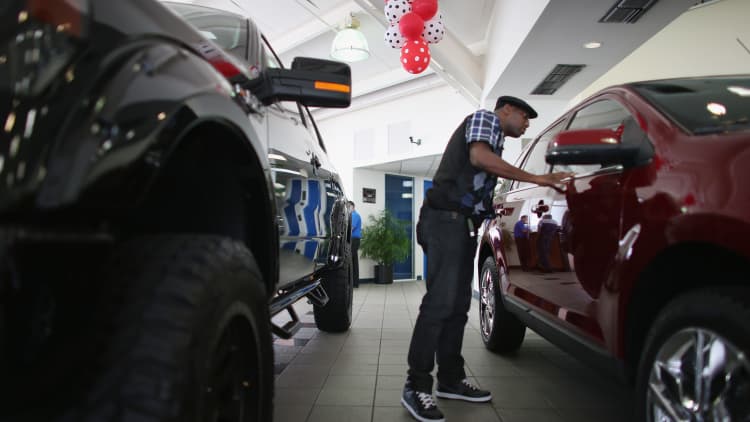Wells Fargo, one of the largest subprime car lenders, is pulling back from that roaring market, a move that is being felt throughout the broader auto industry.
The giant San Francisco bank, known for its stagecoach logo and its steady profits, has been at the center of the boom in making loans to people with tarnished credit scores. Wall Street, meanwhile, has been bundling and selling such loans as securities to investors, reaping big profits while allowing millions of financially troubled borrowers to buy cars.
But now, amid signs that the market is overheating, Wells Fargo has imposed a cap for the first time on the amount of loans it will extend to subprime borrowers.
The bank is limiting the dollar volume of its subprime auto originations to 10 percent of its overall auto loan originations, which last year totaled $29.9 billion, bank executives said.
The decision, detailed in interviews with top Wells Fargo executives, along with other large auto lenders, is a sobering moment for the booming market. Other lenders may decide to take their cue from Wells Fargo, one of the nation's largest lenders. After successfully sidestepping many of the catastrophic mortgage losses that hit its competitors during the financial crisis, the bank has developed a reputation for deftly managing risk.

Over all, auto loans to subprime borrowers — typically people with credit scores at or below 640 — have more than doubled since the financial crisis, with one in four new auto loans going to subprime borrowers. In the second quarter of 2014, for example, total auto loan originations hovered at the highest level since before the financial crisis, according to the Federal Reserve Bank of New York. In that quarter, lenders originated $20.6 billion in subprime auto loans, nearly two times as much as in the same period of 2010.
Behind the surge are two major forces: Large banks, weathering a slowdown in other types of lending like mortgages, have increased their auto lending. And much as in the housing boom, investors in search of higher returns, like insurance companies and hedge funds, are buying billions of dollars of investments backed by subprime auto loans.
Read MoreAuto loans surge, but who's buying may surprise you
Such growth, though, has given rise to concerns, like those at Wells Fargo, that growing competition is fostering lax lending practices, including longer repayment periods and increased loan balances.
Federal and state authorities, meanwhile, are examining whether dealerships have been inflating borrowers' income or falsifying employment information on loan applications to ensure that any borrower, even some who are unemployed and have virtually no source of income, can buy a car.
More broadly, many of the questionable lending practices, while not necessarily illegal, could eventually spell losses for banks and investors, credit analysts and regulators say. The size of the subprime auto loan market is a fraction of the subprime mortgage market at its peak, but its crash would still have wide-reaching effects for banks and borrowers, including some of the most vulnerable Americans.
They are people like Zheng Hui Dong, a Chinese immigrant who bought a 2010 Honda Civic from a dealership in Queens for a total cost over the life of the loan of $42,000 — or nearly four times the resale value of the car, according to court records. And Beatriz Rodriguez of Queens, who filed for bankruptcy last year, but still tries to keep up with her $900 monthly payments on the Honda she uses to take care of her grandchildren.

The troubles of these borrowers, both regulators and credit analysts say, underscore the disturbing signs throughout the lending market.
Last week at the annual conference of the Global Association of Risk Professionals in New York, Darrin Benhart, a senior regulatory official at the Office of the Comptroller of the Currency, which regulates Wells Fargo, noted that lenders had extended repayment periods to 84 months — 40 percent longer than the typical period — and were making loans that were far greater than the value of the car.
"Let that sink in," he told the audience. "That means it is not uncommon today for a family with subprime credit to take a loan at 110 percent of a used car's value that they will be paying off for seven years."
More from The New York Times:
Chip makers will merge in deal worth $11.8 billion
Data security is becoming the sparkle in Bitcoin
Netanyahu's speech opens political divisions in Israel, too
Such longer loan terms, the Wells Fargo executives said, helped inform the bank's decision to impose a cap on its subprime auto originations.
Longer loan terms, while decreasing a borrower's monthly payment, can prove dangerous for lenders. If a borrower falls behind, the remaining loan balance is usually so large that it eclipses the money the lender can recoup through repossessing the car and reselling it at auction.
That calls into question one of the hallmarks of subprime auto lending: the ability to repossess a car and minimize a lender's losses.
Another pressure on the market, analysts worry, is that the value of used cars will plunge amid increased supply. The lower the value of the car, the less money a lender can recoup in a repossession.
Signs of strain are already starting to materialize. Losses on investments backed by subprime auto loans in January reached their highest level since 2009, according to a report last week by Fitch Ratings. The percentage of loans that were delinquent by 60 days or more rose to 4.75 percent in January, up 24 percent from the same period in 2014.
In some ways, the decision by Wells Fargo to cap its subprime auto originations at 10 percent is sending a more chilling message, given the bank's reputation for strong risk management.
The bank's recently imposed cap is already rippling through the auto market. Wells Fargo, like its bank rivals, makes most of its loans through auto dealers. The dealers interact with the borrowers and send their loan applications to prospective lenders.
Increasingly, Wells Fargo has been rejecting loans that dealers expected would be approved, according to people briefed on the matter who were not authorized to speak publicly.
The Wells Fargo executives emphasized in the interviews that they remained committed to auto lending and had no plans to abandon subprime auto loans altogether.
Currently, Wells Fargo's subprime auto loans are around 10 percent of its total auto originations, the executives said. The bank decided to put the cap in place near the end of last quarter. Executives briefed the board on the move late last year.
Some credit analysts expect other lenders to follow the lead of Wells Fargo. At Capital One, Richard Fairbank, the chief executive, has noted that auto lending standards have loosened, in part because they were so tight in the aftermath of the financial crisis.
Capital One, which said in a February regulatory filing that it had received a subpoena from the Manhattan district attorney related to its subprime auto lending business, says it maintains strict underwriting standards.
Still, Mr. Fairbank told analysts in January that the bank had to remain "very, very vigilant."

